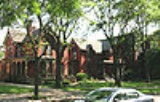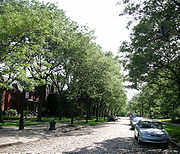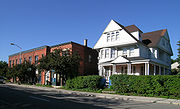
West Canfield Historic District
Encyclopedia
The West Canfield Historic District is a neighborhood historic district
located primarily on Canfield Avenue between Second and Third Streets in Detroit, Michigan
. A boundary increase enlarged the district to include buildings on Third Avenue between Canfield and Calumet. The district was designated a Michigan State Historic Site in 1970 and listed on the National Register of Historic Places in 1971; a boundary increase was added in 1997. The revitalized 1870s era neighborhood is one of the residential areas surrounding the city's Cultural Center Historic District
in Midtown. Nearby, East Canfield Avenue leads to the Detroit Medical Center
complex, the Romanesque Revival
styled St. Josaphat's Catholic Church
, and the Gothic revival
styled Sweetest Heart of Mary Catholic Church
.
 The area around the West Canfield Historic District was once owned by Lewis Cass
The area around the West Canfield Historic District was once owned by Lewis Cass
, an early governor of Michigan. When he died in 1866, his two daughters inherited his holdings. Three years later, they divided the property, with Cass's daughter Mary receiving the portion where the West Canfield Historic District is now located. Mary's husband was Captain August Canfield, a graduate of West Point and a major investor in the construction of the ship canal
at Sault Ste. Marie
. In 1871, Mary Cass Canfield subdivided her land, naming Canfield Avenue in honor of her husband.
The street was populated by prosperous attorneys, physicians, dentists, architects, and other professionals. Construction continued into the 1880s. The street remained a prime residential location in Detroit for decades. In the 1930s, the Great Depression
led to a decline in the neighborhood. In the 1960s, the neighborhood was revitalized and the historic streetscape was restored. New residents have continued to maintain and revitalize the vibrant Midtown neighborhood in the 21st century.
 In the 1960s, the street was narrowed and returned to its original 1870s design with granite pavers, reproduction street lamps were installed, trees were planted, and grassy medians were added. In 1970, the District received state and local historical designation, the first district so recognized in the city. The district was placed on the National Register of Historic Places
In the 1960s, the street was narrowed and returned to its original 1870s design with granite pavers, reproduction street lamps were installed, trees were planted, and grassy medians were added. In 1970, the District received state and local historical designation, the first district so recognized in the city. The district was placed on the National Register of Historic Places
the following year. In 1997, District was expanded to include three buildings on Third Street: one additional Queen Anne style residence and two Victorian commercial buildings. In the new millennium, the vibrant neighborhood has experienced many renovations.
Historic district (United States)
In the United States, a historic district is a group of buildings, properties, or sites that have been designated by one of several entities on different levels as historically or architecturally significant. Buildings, structures, objects and sites within a historic district are normally divided...
located primarily on Canfield Avenue between Second and Third Streets in Detroit, Michigan
Michigan
Michigan is a U.S. state located in the Great Lakes Region of the United States of America. The name Michigan is the French form of the Ojibwa word mishigamaa, meaning "large water" or "large lake"....
. A boundary increase enlarged the district to include buildings on Third Avenue between Canfield and Calumet. The district was designated a Michigan State Historic Site in 1970 and listed on the National Register of Historic Places in 1971; a boundary increase was added in 1997. The revitalized 1870s era neighborhood is one of the residential areas surrounding the city's Cultural Center Historic District
Cultural Center Historic District
The Cultural Center Historic District is a historic district located in Midtown Detroit, Michigan, which includes the Art Center : the Detroit Public Library, the Detroit Institute of Arts, and the Horace H. Rackham Education Memorial Building were listed on the National Register of Historic Places...
in Midtown. Nearby, East Canfield Avenue leads to the Detroit Medical Center
Detroit Medical Center
The Detroit Medical Center, located in Midtown Detroit, Michigan, has more than 2,000 licensed beds, 3,000 affiliated physicians and over 12,000 employees. The DMC is the affiliated clinical research site for medical program at Wayne State University...
complex, the Romanesque Revival
Romanesque Revival architecture
Romanesque Revival is a style of building employed beginning in the mid 19th century inspired by the 11th and 12th century Romanesque architecture...
styled St. Josaphat's Catholic Church
St. Josaphat's Roman Catholic Church
St. Josaphat's Roman Catholic Church is a Roman Catholic church located at 715 E. Canfield Avenue in Detroit, Michigan. It was listed on the National Register of Historic Places in 1982 and designated a Michigan State Historic Site in 1985.- History :...
, and the Gothic revival
Gothic Revival architecture
The Gothic Revival is an architectural movement that began in the 1740s in England...
styled Sweetest Heart of Mary Catholic Church
Sweetest Heart Of Mary Roman Catholic Church
Sweetest Heart of Mary Roman Catholic Church is located at 4440 Russell Street in Detroit, Michigan in the Forest Park neighborhood on the city's central East side. The Gothic Revival Cathedral styled Church is the largest of the Roman Catholic Churches in the City of Detroit...
.
History

Lewis Cass
Lewis Cass was an American military officer and politician. During his long political career, Cass served as a governor of the Michigan Territory, an American ambassador, a U.S. Senator representing Michigan, and co-founder as well as first Masonic Grand Master of the Grand Lodge of Michigan...
, an early governor of Michigan. When he died in 1866, his two daughters inherited his holdings. Three years later, they divided the property, with Cass's daughter Mary receiving the portion where the West Canfield Historic District is now located. Mary's husband was Captain August Canfield, a graduate of West Point and a major investor in the construction of the ship canal
Soo Locks
The Soo Locks are a set of parallel locks which enable ships to travel between Lake Superior and the lower Great Lakes. They are located on the St. Marys River between Lake Superior and Lake Huron, between the Upper Peninsula of the US state of Michigan and the Canadian province of Ontario...
at Sault Ste. Marie
Sault Ste. Marie, Michigan
Sault Ste. Marie is a city in and the county seat of Chippewa County in the U.S. state of Michigan. It is in the north-eastern end of Michigan's Upper Peninsula, on the Canadian border, separated from its twin city of Sault Ste. Marie, Ontario, by the St. Marys River...
. In 1871, Mary Cass Canfield subdivided her land, naming Canfield Avenue in honor of her husband.
The street was populated by prosperous attorneys, physicians, dentists, architects, and other professionals. Construction continued into the 1880s. The street remained a prime residential location in Detroit for decades. In the 1930s, the Great Depression
Great Depression
The Great Depression was a severe worldwide economic depression in the decade preceding World War II. The timing of the Great Depression varied across nations, but in most countries it started in about 1929 and lasted until the late 1930s or early 1940s...
led to a decline in the neighborhood. In the 1960s, the neighborhood was revitalized and the historic streetscape was restored. New residents have continued to maintain and revitalize the vibrant Midtown neighborhood in the 21st century.
Architecture
In the early 1870s, numerous brick Queen Anne homes were constructed along Canfield, on spacious lots with generous setbacks. The original platting specified that each lot would measure 50 by 190 feet, and that there would be "a 30 foot setback for sidewalk, shrubbery, and ornamental purposes."
National Register of Historic Places
The National Register of Historic Places is the United States government's official list of districts, sites, buildings, structures, and objects deemed worthy of preservation...
the following year. In 1997, District was expanded to include three buildings on Third Street: one additional Queen Anne style residence and two Victorian commercial buildings. In the new millennium, the vibrant neighborhood has experienced many renovations.

